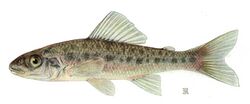Biology:Acanthomorpha
| Acanthomorpha | |
|---|---|

| |
| Trout-perch (P. omiscomaycus) | |
| Scientific classification | |
| Domain: | Eukaryota |
| Kingdom: | Animalia |
| Phylum: | Chordata |
| Class: | Actinopterygii |
| Clade: | Ctenosquamata |
| (unranked): | Acanthomorpha Rosen, 1973[1] |
| Orders | |
|
See text | |
Acanthomorpha (meaning "thorn-shaped") is an extraordinarily diverse taxon of teleost fishes with spiny fin rays. The clade contains about one-third of the world's modern species of vertebrates: over 14,000 species.[2]
A key anatomical innovation in acanthomorphs is hollow and unsegmented spines at the anterior edge of the dorsal and anal fins.[3] A fish can extend these sharp bony spines to protect itself from predators, but can also retract them to decrease drag when swimming.[4] Another shared feature is a particular rostral cartilage, associated with ligaments attached to the rostrum and premaxilla, that enables the fish to protrude its jaws considerably to catch food.[5]
Rosen coined the name in 1973 to describe a clade comprising Acanthopterygii, Paracanthopterygii, and also ctenothrissiform fossils from the Cretaceous period, such as Aulolepis and Ctenothrissa. Those fossils share several details of the skeleton, and especially of the skull, with modern acanthomorphs.[1] Originally based on anatomy, Acanthomorpha has been borne out by more recent molecular analyses.[6]
The oldest acanthomorphs were initially reported by Louis Agassiz from the Cenomanian Sannine Formation of Lebanon, and were considered as such for over a century until slightly older remains were identified from the end-Albian of Mexico. Early acanthomorph fossils are diverse and well-preserved in formations from the early part of the Late Cretaceous from the Cenomanian to the Campanian, but become exceedingly rare throughout the Maastrichtian and the Paleocene (spanning the likely origins of a number of modern taxa) before a second explosion in fossil abundance and diversity in the Eocene. This mysterious gap is known as "Patterson's Gap" after paleontologist Colin Patterson, who first identified it in 1993.[7]
Phylogeny
The phylogeny of living bony fishes[8][9][10][11]
| Acanthomorpha |
| ||||||||||||||||||||||||||||||||||||||||||||||||||||||
Fossil record and evolutionary history
Some otoliths, calcium carbonate structures that form the ears of fishes, have been found from the Jurassic Period that may belong to acanthomorphs, but the oldest body fossils from this taxon are only known from the middle of the Cretaceous Period, about 100 million years ago. Acanthomorphs from the early Late Cretaceous were small, typically about 4 centimeters long, and fairly rare.[12] Toward the beginning of the Cenozoic era, they exploded in an adaptive radiation, so by the time their fossils begin appear more frequently in Eocene-aged strata, they had reached their modern diversity of 300 families.[4]
Recently discovered fish scales from Poland suggest that the oldest acanthomorphs occurred in the Late Triassic.[13]
References
Notes
- ↑ 1.0 1.1 Rosen, Donn Eric (1973), "Interrelationships of higher euteleostean fishes", in Greenwood, P.H.; Miles, R.S.; Patterson, Colin, Interrelationships of Fishes, Academic Press, pp. 397–513, ISBN 0-12-300850-6
- ↑ Chen, Wei-Jen; Bonillo, Céline; Lecointre, Guillaume (2003). "Repeatability of clades as a criterion of reliability: a case study for molecular phylogeny of Acanthomorpha (Teleostei) with larger number of taxa". Molecular Phylogenetics and Evolution 26 (2): 262–288. doi:10.1016/s1055-7903(02)00371-8. PMID 12565036.
- ↑ acanthomorphs group, of the phylogeny team, "What are the acanthomorphs?", AcanthoWeb (UPMC, Paris – UMR 7138, Systématique, Adaptation, Évolution), http://www.acanthoweb.fr/en/content/what-are-acanthomorphs, retrieved October 24, 2012
- ↑ 4.0 4.1 Maisey, John G. (1996), Discovering fossil fishes, Henry Holt & Company
- ↑ Johnson, G. David; Wiley, E.O. (2007), "Acanthomorpha", Tree of Life Web Project, http://tolweb.org/Acanthomorpha/15088, retrieved October 24, 2012
- ↑ Near, Thomas J.; Eytan, Ron I.; Dornburg, Alex; Kuhn, Kristen L.; Moore, Jon A.; Davis, Matthew P.; Wainwright, Peter C.; Friedman, Matt et al. (2012). "Resolution of ray-finned fish phylogeny and timing of diversification". PNAS 109 (34): 13698–13703. doi:10.1073/pnas.1206625109. PMID 22869754. Bibcode: 2012PNAS..10913698N.
- ↑ Friedman, Matt; V. Andrews, James; Saad, Hadeel; El-Sayed, Sanaa (2023-06-16). "The Cretaceous–Paleogene transition in spiny-rayed fishes: surveying “Patterson’s Gap” in the acanthomorph skeletal record André Dumont medalist lecture 2018" (in en). Geologica Belgica. doi:10.20341/gb.2023.002. ISSN 1374-8505. https://popups.uliege.be/1374-8505/index.php?id=7048.
- ↑ Betancur-R (2013). "The Tree of Life and a New Classification of Bony Fishes.". PLOS Currents Tree of Life 5 (Edition 1). doi:10.1371/currents.tol.53ba26640df0ccaee75bb165c8c26288. PMID 23653398.
- ↑ Betancur-R (2013). "Complete tree classification (supplemental figure)". PLOS Currents Tree of Life (Edition 1). http://www.deepfin.org/images/Fig_S1_Complete_tree_classification.pdf.
- ↑ Betancur-R (2013). "Appendix 2 – Revised Classification for Bony Fishes". PLOS Currents Tree of Life (Edition 1). http://currents.plos.org/treeoflife/files/2013/04/Appendix_2_Classification1.pdf.
- ↑ Betancur-Rodriguez (2016). "Phylogenetic Classification of Bony Fishes Version 4". https://sites.google.com/site/guilleorti/classification-v-4.
- ↑ Stewart, J.D. (1996), "Cretaceous acanthomorphs of North America", in Arratia, Gloria; Viohl, Günter, Mesozoic Fishes – Systematics and Paleoecology, Verlag Dr. Friedrich Pfeil, pp. 383–394, ISBN 3-923871-90-2
- ↑ Antczak, Mateusz; Bodzioch, Adam (January 2018). "Diversity of Fish Scales in Late Triassic Deposits of Krasiejów (SW Poland)" (in en-US). Paleontological Research 22 (1): 91–100. doi:10.2517/2017pr012. ISSN 1342-8144.
Sources
- Sepkoski, Jack (2002). "A compendium of fossil marine animal genera". Bulletins of American Paleontology 364: 560. http://strata.ummp.lsa.umich.edu/jack/showgenera.php?taxon=611&rank=class. Retrieved 2011-05-17.
- TJ Near; A Dornburg; RI Eytan et al. (2013). "Phylogeny and tempo of diversification in the superradiation of spiny-rayed fishes". Proceedings of the National Academy of Sciences of the United States of America 110 (31): 12738–12743. doi:10.1073/pnas.1304661110. PMID 23858462. Bibcode: 2013PNAS..11012738N.
Wikidata ☰ Q337777 entry
 |

